HD430
back to Sennheiser
back to measurements
home
published: Jan-23-2022
NO SMOOTHING is applied to the shown plots. Most measurement sites have some smoothing applied which ‘irons flat’ sharp peaks and ‘wiggles’. I do not use smoothing because some info about sound quality is lost when plots are smoothed.
Aside from a small correction of the microphone itself also some correction in the lowest frequencies is applied to the plots to compensate for the perceived loss of bass when using headphones. This is described HERE in more detail.
A ‘horizontal‘ frequency response curve on the shown frequency response plots on this website thus indicates a perceived ‘flat’ tonal signature.
ALL measurements are made with a good SEAL on a flatbed measurement rig.
The shape of your head, bone structure, pad size, pad ‘softness, (compliance), hair or no hair and or wearing glasses may (drastically) change the frequency response of some headphones, so… your personal experience may differ substantially from these plots.
Frequency response (tonal balance) is the most sound-determining aspect of headphones. A horizontal line shows audible neutral response in the plots on this website. Deviations in different severities at different frequency bands have an effect on the sound character.
The bigger the deviation the stronger the effect.
Below an aid to help determining the sound character of headphones with relation to the frequency response.

Sennheiser HD 430

The Sennheiser HD 430 is an open over-ear dynamic headphone. The headphone came out in 1979 and was the top model back then. It was superseded by the HD 530 in 1985.
It looks quite nice with its gold accents.
The headband is made of 1 piece plastic and has a plastic headrest that can be adjusted. The construction is very simple yet durable (over 40 years old). It still functions as when new. The headband is wide but not padded and together with the low weight (190 gram without the cable) it is quite comfortable.
Despite its sober construction it functions pretty well. The cups can easily swivel and tilt far enough and the headband can stretch wide enough to fit most if not all heads.
Comfort is quite high. The pads can get a bit warm and sweaty on warm days. Clamping force is low (3N). The original pads still available (including the foam discs).
The HD430 could be bought with 3 different cables. 1 cable with 2 DIN loudspeaker connectors (which makes a lot of sense), 1 cable with 3.5/6.3mm TRS jack and 1 cable with the 5-pin DIN ‘dice’ plug used for headphones in those days. Those cables terminated in the familiar 2-pin Sennheiser connectors.
The drivers are rated at 600Ω (measured 560Ω) which is still quite high even for today’s standards. Nowadays there aren’t many headphones around in this impedance range but they still exist. The advantage is (was) it can be driver directly from the output of a power amp and one could use lots of them in parallel in studios on one amp without needing a distribution amp. You need a more ‘serious’ amplifier to make it sing a bit more convincing. Think of headphone amplifiers that can supply a high power output level in 300Ω headphones, OTL tube amps and speaker outputs of integrated amps.
With 97dB/V this headphone is quite insensitive so needs an amplifier with enough gain and output voltage to get a good sound level/quality.
The foam behind the driver (for damping the headphone) was still there but was completely decayed.
The foam disc in front of the driver also was completely gone. For measurements this was replaced with new foam. The pads the headphone came with were aftermarket pads. Several pads including original ones were used but the response did not change much.
specifications:
Type: over-ear, open.
Isolation: none
Usage: home and studio.
Driver type: dynamic
Pads: thin pleather with regular foam.
Foldable: No
Headphone cup connector: 2-pin Sennheiser connector.
Cable entry: dual sided
Cable: 3m cable with 3 connector options when buying the headphone.
Inner Pad dimensions: depth = 20mm , diameter = 49mm.
Driver size: 32mm
Max power rating: 0.1 W
Max Input Voltage: 7.5 Vrms (21 Vpp)
Max drawn current: 13 mA
Max. S.P.L.: 114 dB
Impedance: 560 Ω
Efficiency: 94dB @ 1mW
Sensitivity: 97dB @ 1V
Weight: 190 g.
Clamping force: low 3N
Accessories: 3m cable.
Sound description:
Bass is not there at all. No warmth/fullness either. This headphone is only about the mids and treble. Mids are not very dynamic sounding but do have some quality to it. Clarity is slightly lacking but not in an obvious way. Treble is there and has some sharpness to it but is not of poor quality. The treble is neither grainy nor smooth.
Measurements:
Below the frequency response of the HD430 (Left, Right)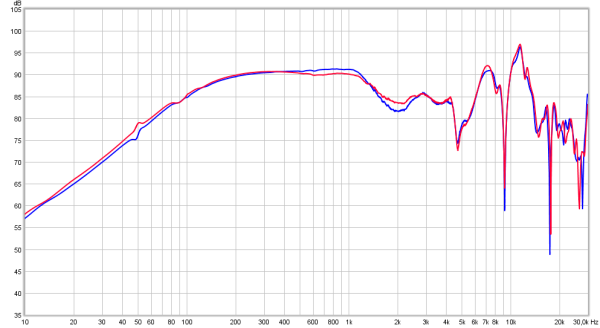 Channel matching is excellent. Obviously this wasn’t an issue about 40 years ago.
Channel matching is excellent. Obviously this wasn’t an issue about 40 years ago.
Bass rolls off audible below 200Hz. Mids are ‘flat’ from 200Hz to 1kHz with a 5dB drop from 1kHz to 3kHz. Frequency response extends beyond 20kHz and is peaking at around 11kHz.
compared to
Below alternating every 3 seconds the HD430 compared to the HD414, HD420-SL, HD560-Ovation-II, HD650, K400, K500 and SR125i.
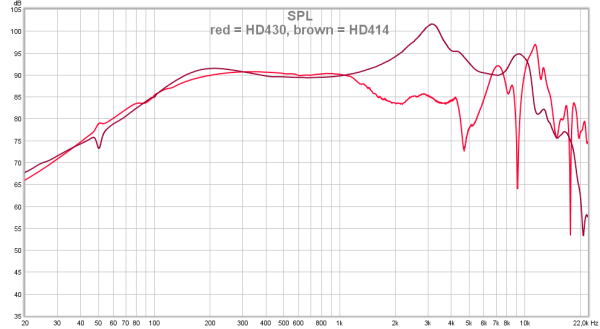
output resistance / damping-factor
As this is a dynamic headphone the frequency response can be amplifier output resistance dependent when certain higher output resistance amplifiers are used.
Instead of showing impedance plots, which are hard to ‘read’ when it comes to assessing the tonal balance change in the real world, the HD430 is measured via a few different resistance outputs (0.2Ω, 10Ω, 32Ω and 120Ω). On a higher output resistance amplifier the output level will be lower of course due to voltage division. To compensate for this the amplifier is turned up to the same level (1.6dB for 120Ω at 1kHz in this case). This way the plots are overlaid and it is easier to see how the tonal balance changes. 
This headphone can be used from just about any output resistance, provided enough voltage is available. The tonal balance does not change on higher output resistance amplifiers.
Below the distortion plot of the HD430 (Left channel shown)
Below the same data but shown in a percentage scale instead of a dB scale.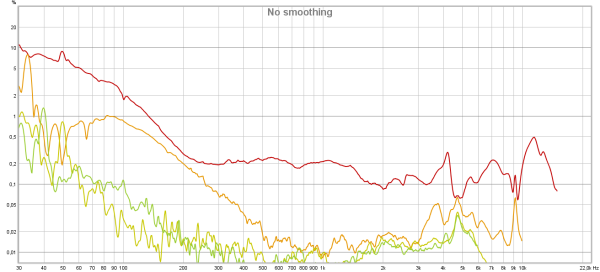
The 2nd harmonic distortion in the bass area is, not unexpectedly, not very low and reaches about 5% in the bass area. From 200Hz to 4kHz the distortion is below 0.2% which is not bad for a 40 y.o. headphone.
Below the phase response of the HD430 (right channel only)
The drivers appear to be connected in reverse phase. Strangely enough the schematic suggests the phase is correctly connected and the cable also measures correctly. This (2nd hand) headphone came with an aftermarket cable that was incorrectly wired. The thicker pin, which is supposed to be connected to sleeve, was connected to the + of the driver.
Slow phase shifts are not very audible. Sharp changes in a narrow frequency bands may well be audible.
Only above 5kHz there are some sharper but substantial phase shifts.
Linearity
While there was no reason to suspect linearity issues seeing 3rd harmonic distortion is not high the HD430 is measured 4 times. Once at 70dB, 80dB, 90dB and 96dB SPL. When the traces are overlaid and have the same shape then there is no compression.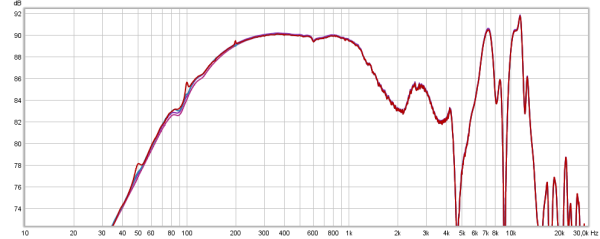 Note the 2dB/div scale. There is no compression going on until at least 96dB SPL.
Note the 2dB/div scale. There is no compression going on until at least 96dB SPL.
seal
Seal can be an issue with closed-back headphones. Much less so with open headphones, which the HD430 is. Perfect seal, pads lifted a few mm.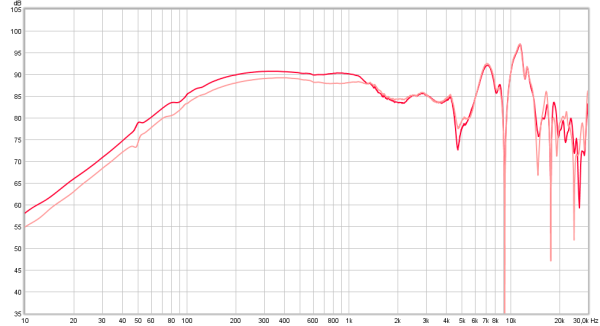
Breaking the seal does not make much of a difference. Perfect seal thus is not a requirement.
Below the CSD of the HD430 (Left and Right channel are superimposed)
Above 3kHz there are several, but not long, resonances. Driver damping for higher frequencies is not that great.
The Group Delay plot below shows some small pad bounce around 80Hz and some resonances at 4.7kHz and 9kHz.
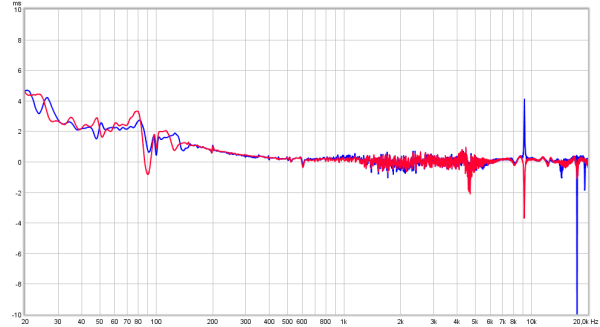
Another form of looking in the time domain is the spectrum plot. 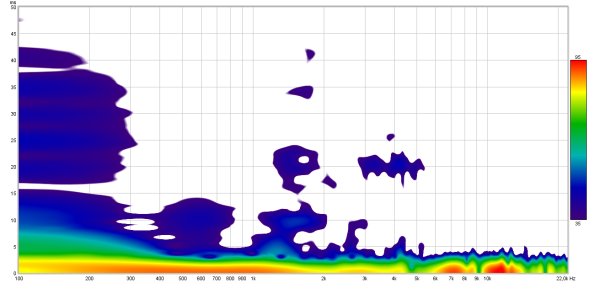 The amplitude is color coded and both the time scale and frequency scale differ as well. The lows are very well damped and ‘clean’ there is no resonance showing there.
The amplitude is color coded and both the time scale and frequency scale differ as well. The lows are very well damped and ‘clean’ there is no resonance showing there.
By lack of oscilloscope shots below a step response plot of the HD430 (Right, Left)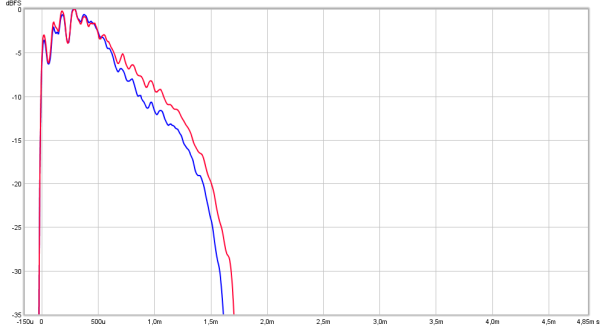
This is a very poor response. No bass extension. After 500μs the output drops fast. This shows the bass shy character. The initial rise does not reach 0dB.
summary
The Sennheiser HD430 was the top model in the dynamic headphone line around 1980. It is a comfortable headphone and has a nice look. The sound is only midrange and treble. The treble has some sharpness to it. With some EQ lowering the upper treble and adding a few dB in the lows the sound improves a bit but the lower bass cannot be EQ’ed in there.
This may have been a nice headphone 40 years ago but is not a desirable model these days.
Those looking for decent sounding older Sennheisers should be looking for models of 1985 and younger.
